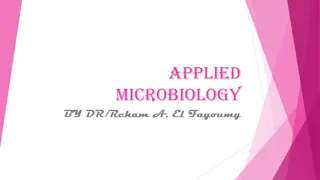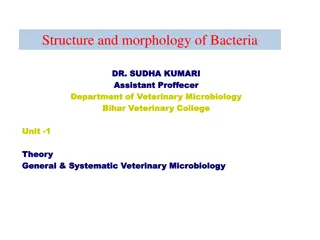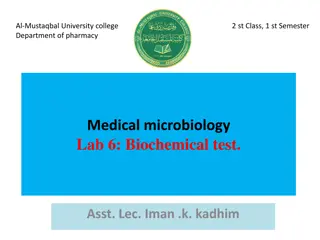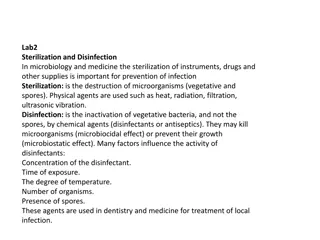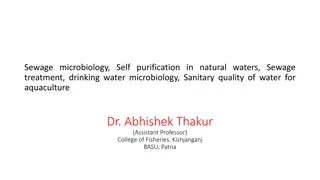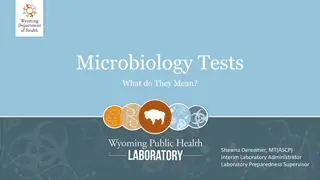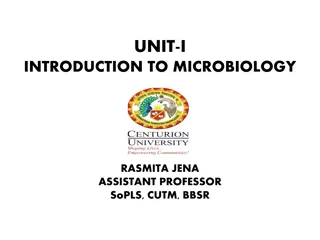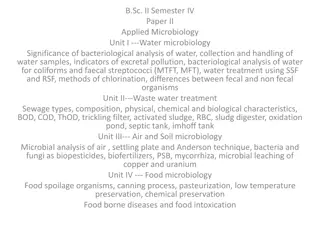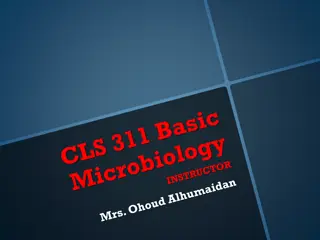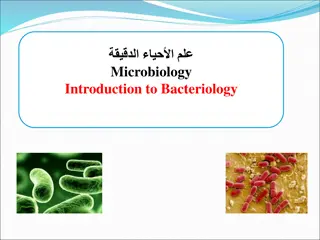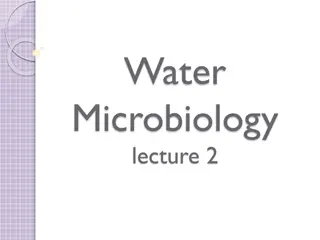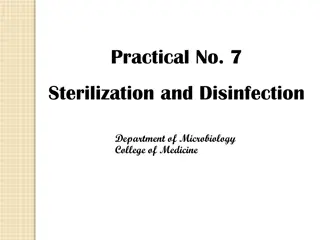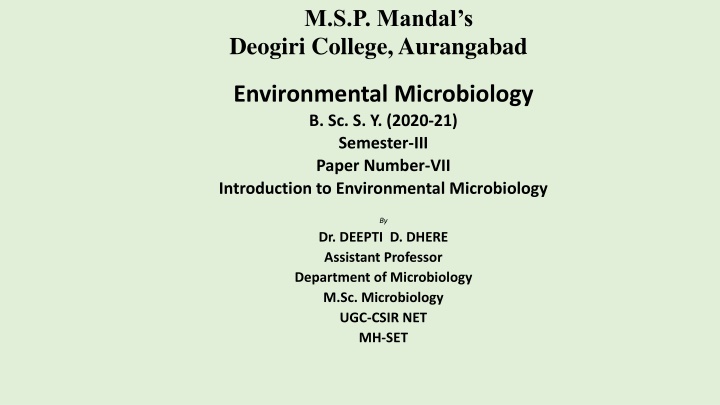
Environmental Microbiology: Focus on Air Microbiology
Environmental microbiology is a branch of microbiology that studies microorganisms in the environment, including air, soil, and water. Air microbiology, a sub-discipline, explores microbes present in the atmospheric air, known as bio-aerosols. This field delves into the composition of air, sources of airborne bacteria, and their impact on air quality. Despite air being an unfavorable environment for microbial growth, understanding air microbiology is crucial for assessing environmental health.
Uploaded on | 1 Views
Download Presentation

Please find below an Image/Link to download the presentation.
The content on the website is provided AS IS for your information and personal use only. It may not be sold, licensed, or shared on other websites without obtaining consent from the author. If you encounter any issues during the download, it is possible that the publisher has removed the file from their server.
You are allowed to download the files provided on this website for personal or commercial use, subject to the condition that they are used lawfully. All files are the property of their respective owners.
The content on the website is provided AS IS for your information and personal use only. It may not be sold, licensed, or shared on other websites without obtaining consent from the author.
E N D
Presentation Transcript
M.S.P. Mandals Deogiri College, Aurangabad Environmental Microbiology B. Sc. S. Y. (2020-21) Semester-III Paper Number-VII Introduction to Environmental Microbiology By Dr. DEEPTI D. DHERE Assistant Professor Department of Microbiology M.Sc. Microbiology UGC-CSIR NET MH-SET
Learning objectives-To know about Environmental Microbiology, specifically Air Microbiology, air as a medium and sources of microorganisms in air. Environmental Microbiology Environmental microbiology is the branch of Microbiology. Environmental microbiology is the scientific study of microorganisms in the environment This discipline includes air microbiology, soil microbiology and water microbiology. Environmental microbiology is the study of the composition and physiology of microbial communities in the environment. The environment in this case means the soil, water, air and sediments covering the planet and can also include the animals and plants that inhabit these areas.
All microbiological aspects that directly or indirectly connected with the environment All microbiological aspects that directly or indirectly connected with the environment are included in Environmental microbiology are included in Environmental microbiology
Air Microbiology Air microbiology is a scientific discipline that concerns the microorganisms, including bacteria, Archaea, fungi and viruses, in the atmospheric air. It is a sub-discipline of environmental microbiology. Air Microbiology is also called as Aero-microbiology. Aero-microbiology is the study of living microbes which are suspended in the air. These microbes are referred to as bio-aerosols.
Composition of Air Air consist of mixture of permanent gases and variable quantity of water and solid particles Air has following composition Sr. No. Name of Gas Percentage 1. Nitrogen 78.03 2. Oxygen 20.99 3. Argon 0.94 4. Carbon Dioxide 0.03 5. Hydrogen 0.01 5. Neon 0.0012 6. Crypton 0.0010 7. Helium 0.0004 8. Zenon 0.0001 9. Ozon variable 10. Water vapour variable
Air as a Medium Earth s atmosphere is teeming (Completely full) with the microorganisms. These organisms are thought to exhibit correlations with air pollution and weather. Most airborne bacteria originate from natural sources such as the soil, lakes, oceans, animals, and humans. Many unnatural origins are also known, such as sewage treatment, animal rendering, fermentation processes, and agricultural activities which disturb the soil. Viable airborne microorganisms are not air pollutants, but should be considered as a factor affecting air quality. Air is an unfavourable environment for microorganisms, in which they cannot grow or divide. It is merely a place which they temporarily occupy and use for movement limiting factors There are 3 elementary in the air- 1. 2. 3. A lack of adequate nutrients Frequent deficit of water (desiccation) Solar radiation
Air is not a natural environment for microorganisms as it does not contains enough moisture and nutrients to support their growth Air is not a medium where microorganisms can grow but it is only a transport medium by which microorganisms can be transported from one place to another place and from one medium to another. The atmosphere can be occupied for the longest time by those forms which are resistant to desiccation and solar radiation due to their chemical composition or structure,. They can be subdivided into the following groups: Bacterial resting forms, Bacterial vegetative forms which produce carotenoid dyes or special protective layers (capsules,special structure of cell wall) Spores of fungi, Viruses with envelopes
Bacterial Resting Forms Endospores are the resting form of bacteria These structures evolve within cells and are covered by a thick multi-layer casing. They are most resistant to desiccation, solar radiation and lack of nutrients Another type of resting form is produced by very common soil bacteria, the Actinomycetes. It is called as conidia. Resistant vegetative cells of bacteria The production of carotenoid dyes ensures cells with solar radiation protection. Carotenoids, due to the presence of numerous double bonds within a molecule (-C=C-), serve a purpose as antioxidants, because, as strong reducing agents, they are oxidized by free radicals. Consequently, important biological macromolecules are being protected against oxidation (DNA, proteins etc.). Bacteria devoid of these dyes quickly perish due to the photodynamic effect of photo-oxidation. That explains why the colonies of bacteria, which settle upon open agar plates, are often colored. The ability to produce carotenoids is possessed especially by cocci and rod-shaped Actinomycetes.
Fungal spores Resistant viruses Spores are special reproductive cells used for asexual reproduction. Fungi produce spores in astronomical quantities, for example the giant puffball (Calvatia gigantea) produces 20 billion spores, which get into the air and are dispersed over vast areas. A very common type of spores found in air is that of conidia. The spores of common mould fungi such as Penicillium and Aspergillus are examples of the above. Besides cells, the air is also occupied by viruses. Among those that demonstrate the highest resistance are those with enveloped nucleocapsids, such as influenza viruses. Besides the previously mentioned resistant forms, the air is also occupied by more sensitive cells and viruses, but their survival is much shorter.
Sources of Microorganisms in Air Air is not a indigenous source of microorganisms but it is a transport medium. In air microorganisms are added by the different sources These sources are- 1. Soil 2. Water 3. Vegetation 4. Human 5. Animals
Biological aerosols Microorganisms in air occur in a form of colloidal system or the so-called bio-aerosol. In the case of biological aerosols, it's the air (or other gases) that has the function of the dispersion medium, whereas microorganisms are its dispersed phase. Microorganisms rarely occur independently in the air Usually, they are bound with dust particles or liquid droplets (water, saliva etc.) Thus the particles of the bio-aerosol often exceed microorganisms in size and may occur in two phases: Dust phase (e.g. bacterial dust) orDroplet phase The dust particles are usually larger than the droplets and they settle faster. The difference in their ability to penetrate the respiratory tract is dependent on the size of the particles. There are several factors which influence the ability of a bio-aerosol to survive in air: 1. Particular resistance for a given microorganism (morphological characteristics) 2. Meteorological conditions (air humidity, solar radiation), air pollution. 3. The length of time in air The average size of bio-aerosols ranges from about 0.02 m to 100 m. The sizes of certain particles may change under the influence of outside factors (mainly humidity and temperature) or as a result of larger aggregates formed.
There are two basic sources of bioaerosol: Natural-Soil, Water, vegetation Related to human activities Natural sources are mainly soil and water, from which microorganisms are being lifted up by the movement of air, and from organisms such as fungi, that produce gigantic amounts of spores that are dispersed by the wind. Therefore, there are always a given number of microorganisms in the air, as a natural background. It is estimated, that the air is considered to be clean, if the concentration of bacteria and fungi cells does not exceed 1000/m3 and 3000/m3 respectively. It is only true when the concentration of microorganisms consists of saprophytic organisms, not pathogenic organisms. If the concentration of microorganisms in the air exceeds the above values, or contains microorganisms dangerous to humans, then such air is considered to be microbiologically polluted. From the hygienic point of view, living sources of bio-aerosols related to human activity, are more important than the natural sources. The emissions from these sources are dangerous due to the following two reasons: They may distribute pathogenic microorganisms, they often cause a high increase of microorganisms in the air, significantly exceeding the natural background. The most important sources of bioaerosol emission are: Agriculture and farming-food industry, Sewage treatment plants, Waste management.
Agriculture and food/farming industry This is the biggest source of bioaerosol emission, which results from the intensification of methods of farm production. Aerosols are created during almost all types of agricultural work, e.g. harvest, transport, storing, plant and animal material processing, and in animal breeding facilities. The significant dangers to human health are brought about by a vast number of microorganisms, products of their decomposition and of organic dust, which have an allergic and toxic affect. The presence of infectious microbes is less significant here. The most important components of the above- mentioned aerosols are: mold fungus, Aspergillus, Penicillium and Cladosporium, Alternaria Gram-negative chromatobacteria, mainly of the genus Erwinia, thermophilic Acitnomycetes, dust of biological origin (among other things: particles of skin, feathers, droppings, plant dust). Contact with such aerosols may often bring about chronic diseases of the respiratory system, e.g. allergic inflammation of pulmonary alveoli (Alveolitis allergica). It is said, that there is an exceptional health risk, when over 50% of the aerosol belongs to the respirable fraction, and bio-aerosol's concentration exceeds 105 cfu/m3. The above quantity is often exceeded a hundred times (e.g. in pigsties, broiler houses, granaries).
Wastewater treatment The biggest emission of microorganisms can be observed in the mechanical section, where raw sewage is introduced (drainage area, grill, sand trap) as well as in the vicinity of aeration tanks and sludge drying beds. Moreover, a strong emission may be also observed during sewage putrification in soil and in sprinkling beds. Significant air pollution may occur in the areas stated above, which may even exceed the level of background concentration. The following are some of the characteristic microorganisms present in bioaerosol and sewage: Intestinal bacteria (Enterobacteriaceae), including those of the coli group, Salmonella, Shigella, Hemolytic bacteria, mainly Streptococcus and Staphylococcus,Pseudomonas bacteria, Yeast such as Candida albicans and Cryptococcus, Dermatophites (surface-mycosis inducing fungus) of Microsporum and Trichophyton Protozoa, Eggs of worms, Intestinal viruses: Enteroviruses and Reoviruses.
Points to Remember Environmental microbiology is the scientific study of microorganisms in the environment This discipline includes air microbiology, soil microbiology and water microbiology. Air is an unfavourable environment for microorganisms, in which they cannot grow or divide. The limiting factors in the air are- A lack of adequate nutrients, Frequent deficit of water (desiccation), Solar radiation In air microorganisms are added by the different sources, these sources are-Soil, Water, Vegetation, Human and Animals Microorganisms in air occur in a form of colloidal system or the so-called bio-aerosol In air only resistant microorganism can stay-they are endospores, fungal spores, conidia, resistant vegetative cells of the bacteria and enveloped viruses



